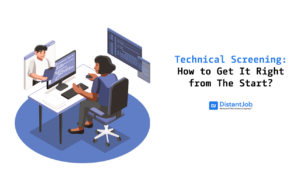With 57% of tech executives stating that finding qualified employees is their biggest concern, recruiting skilled software developers is not as easy as doing a simple interview.
One of the best ways to identify the skills and abilities of developers is with code interview challenges. These can be useful as a filter, particularly when you either have too many candidates or are looking for a specific skill or technology.
While code interview challenges are just one part of the hiring equation, they allow you to determine if developers are up to the specific requirements of the job.
In this blog, we explore the key aspects of code interview challenges, how to design the right coding challenge, and sample code interview questions with solutions to get you started.
6 Useful Code Interview Challenges Examples
We’ve already established that custom coding challenges are preferable to generic ones. But even so, we’ll present you with some examples. Here are some code interview challenges to get inspiration, divided by category:
- Algorithms and Data Structures
- Object Oriented Programming and Design
- Coding Skills
- Handling Edge Cases and Proper Error Handling
- Debugging
- Coding Exercises
Disclaimer: For some of the answer samples, I’ll provide solutions using Python; however, keep in mind that answers may vary depending on the candidate’s language of choice, among other things.
Let’s take a look at each interview coding challenge example and its solution:
1. Data Structures and Algorithms
Data structures and algorithm questions are suitable to assess a candidate’s problem-solving skills and understanding of computational efficiency.
Challenge: Merge Two Sorted Lists
This challenge requires candidates to think about how to merge two sorted arrays efficiently. It tests the candidate’s ability to handle edge cases, such as when one list is exhausted before the other.
Solution Code (Python):
def merge_sorted_lists(list1, list2):
merged_list = []
i, j = 0, 0
while i < len(list1) and j < len(list2):
if list1[i] < list2[j]:
merged_list.append(list1[i])
i += 1
else:
merged_list.append(list2[j])
j += 1
while i < len(list1):
merged_list.append(list1[i])
i += 1
while j < len(list2):
merged_list.append(list2[j])
j += 1
return merged_listChallenge: Check if a String is a Palindrome Using a Stack
While a stack can be used for this (to push and pop characters), the solution provided uses string manipulation and Python’s slicing, showcasing flexibility in solving problems without overcomplicating them. This challenge serves to discuss alternative approaches and when to use them.
Solution Code (Python):
def is_palindrome(s):
alphanumeric_str = [char.lower() for char in s if char.isalnum()]
return alphanumeric_str == alphanumeric_str[::-1]Challenge: Implement a Binary Search Tree (BST) Insert and Search
This challenge requires knowledge of BST operations and properties, such as how elements are inserted or found, based on their values. Both insertion and search operations are recursive in BSTs. This tests the candidate’s comfort with recursion, a powerful tool in many algorithms and data structure manipulations.
Solution Code (Python):
class TreeNode:
def __init__(self, value=0, left=None, right=None):
self.value = value
self.left = left
self.right = right
class BinarySearchTree:
def __init__(self):
self.root = None
def insert(self, value):
self.root = self._insert_recursive(self.root, value)
def _insert_recursive(self, node, value):
if node is None:
return TreeNode(value)
if value < node.value:
node.left = self._insert_recursive(node.left, value)
else:
node.right = self._insert_recursive(node.right, value)
return node
def search(self, value):
return self._search_recursive(self.root, value)
def _search_recursive(self, node, value):
if node is None or node.value == value:
return node is not None
elif value < node.value:
return self._search_recursive(node.left, value)
else:
return self._search_recursive(node.right, value)2. Object Oriented Programming and Design
Evaluating OOP and design is useful to understand a candidate’s ability to structure code in a modular, reusable and scalable manner, which is relevant for building complex, maintainable software systems.
Challenge: Design a Parking Lot
This challenge focuses on assessing the candidate’s skills when it comes to designing a system with multiple interacting components, handling complexity through object-oriented design principles, and considering scalability and extensibility.
Problem: Design a basic parking lot system using object-oriented programming. The system should support different types of vehicles (car, truck, motorcycle) and would have multiple floors where vehicles can be parked.
What Candidates Should Do:
- Create a class hierarchy with a base class Vehicle and derived classes for each vehicle type (Car, Truck, Motorcycle). Use polymorphism to treat all vehicle types uniformly.
- IImplement classes for ParkingLot, ParkingFloor, and ParkingSpot to encapsulate the behaviors and properties of the parking lot system.
- Use association to model the relationships between the parking lot, floors, and parking spots.
Challenge: Implement a Library Management System
This challenge encapsulates the understanding of basic OOP principles, class relationships, and how to encapsulate data and behavior within classes to represent real-world entities and relationships.
Problem: Design a simple library management system using OOP. The system should allow for adding books, tracking borrowed books, and managing users.
What Candidates Should Do:
- Use classes for Book, User, and Library. Book can have properties like title, author, and ISBN. User might have details such as name and a list of borrowed books.
- Library could aggregate Book objects and associate with User objects to track which user has borrowed which book.
- Implement methods in Library for addBook, borrowBook, and returnBook, ensuring that the state of the library is correctly managed.
Challenge: Design a Chess Game
Designing a chess game challenges candidates to model a complex system with various interacting pieces and rules, requiring deep thinking on class hierarchy, polymorphism, and advanced design patterns for flexibility and maintainability.
Problem: Design the classes and interfaces for a chess game using object-oriented principles.
What Candidates Should Do:
- Create an abstract class Piece with subclasses like Pawn, Rook, Knight, etc., each implementing movement rules.
- Use a Board class to encapsulate the arrangement of pieces and control the game flow. Game class to manage players, turns, and game status.
- Implement the Command pattern for move generation and execution, allowing for undo functionality and more flexible game logic.
3. Quality of Code
Challenge: Refactor Duplicate Code
Tests the candidate’s ability to recognize and eliminate redundancy in code.
Problem: You are given two functions that contain largely duplicated code with minor differences. The task is to refactor these functions into a single function or multiple smaller functions, eliminating duplication while preserving functionality.
What Candidates Should Do:
- Identify the common parts of the functions and abstract them into their own function(s).
- Use parameters for the parts that differ between the original functions.
- Ensure the refactored code is easier to read and maintain than the original code.
Challenge: Optimize a Slow Function
This challenge is useful to evaluate the candidate’s understanding of algorithm efficiency, their ability to diagnose performance issues and their skill in applying optimizations that significantly improve performance.
Problem: A provided function performs a task (e.g., sorting, searching, or aggregating data) but runs inefficiently for large inputs. Optimize this function to reduce its time and/or space complexity without using built-in language features that trivialize the task (like using a sorting library for a sorting task).
What Candidates Should Do:
- Analyze the current algorithm and identify bottlenecks or inefficient operations.
- Consider if a change in data structure could improve performance.
- For algorithms with repetitive calculations, use caching or memoization to save results of expensive function calls.
Challenge: Improve Code Maintainability
Measures the candidate’s understanding of what makes code readable and maintainable, including their approach to naming, structuring code, and documenting their work.
Problem: Review a piece of code that is hard to understand due to poor variable naming, lack of modularity, or absence of comments. Improve the maintainability of the code by refactoring it with better practices.
What Candidates Should Do:
- Use descriptive and meaningful names for variables, functions, and classes.
- Break down large functions or classes into smaller, more manageable pieces.
- Add comments and documentation where necessary to explain why certain decisions were made or how complex sections of code work.
4. Handling Edge Cases and Proper Error Handling
Evaluating handling edge cases and proper error handling reveals a candidate’s ability to anticipate and manage exceptional or unexpected conditions, ensuring software reliability.
Challenge: Validate User Input
With this challenge, you can evaluate a candidate’s ability to anticipate and handle incorrect input formats and values, emphasizing the importance of validating external inputs to maintain data integrity and prevent errors.
Problem: Write a function that accepts user input for a date in the format “YYYY-MM-DD” and checks whether it’s a valid date. The function should handle cases where the date is in the wrong format, or the values are out of range (e.g., month is greater than 12 or day is greater than 31).
What Candidates Should Do:
- Use Regular Expressions to ensure the format is correct.
- Check if the constructed date is valid using built-in date libraries.
- Error Handling: If input is invalid, raise a custom exception or return a meaningful error message.
Example (Using Python):
import re
from datetime import datetime
def validate_date(user_input):
if not re.match(r"\d{4}-\d{2}-\d{2}", user_input):
raise ValueError("Date must be in YYYY-MM-DD format.")
try:
valid_date = datetime.strptime(user_input, "%Y-%m-%d")
except ValueError:
raise ValueError("Invalid date.")
return valid_dateChallenge: Safe Division
This challenge highlights the candidate’s foresight in handling common mathematical errors, demonstrating their ability to write code that anticipates and gracefully handles runtime errors.
Problem: Implement a function for division that safely handles division by zero and returns a custom error message or value in such cases.
What Candidates Should Do:
- Explicitly check if the denominator is zero before attempting division.
- Return a predefined value or error message when division by zero is attempted.
Example (using Python):
def safe_division(num, denom):
if denom == 0:
return "Error: Division by zero is undefined."
return num / denomExample 3: File Handling with Proper Cleanup
With this assessment, you can evaluate a candidate’s understanding of resource management, ensuring resources like files are correctly managed even in error conditions, which is crucial for preventing resource leaks and ensuring data consistency.
Problem: Write a function to read data from a file and process it. Ensure that the file is properly closed in case of an error during reading or processing.
What Candidates Should Do:
- Use a context manager (with statement in Python) for safe file handling.
- Try-Except-Finally: Ensure cleanup actions are taken, even if an error occurs.
Example (using Python):
def process_file(file_path):
try:
with open(file_path, 'r') as file:
data = file.read()
# Process data
except IOError:
return "Error: File cannot be read."
except Exception as e:
return f"An error occurred: {e}"
# No need for finally block with context manager; file is automatically closed5. Debugging
Debugging challenges involve identifying, isolating, fixing bugs or errors that were not anticipated or handled initially. This is important to ensure that code is reliable and functions correctly under all expected conditions.
Challenge: Fix a Loop Error in a Data Processing Function
Problem: A loop intended to increment an index or conditionally process elements doesn’t update the index or condition correctly.
Solution (example):
# Bug Example
i = 0
while i < len(numbers):
if numbers[i] % 2 == 0:
# Process even numbers
pass
# Missing increment or incorrect condition update
# Fixed Example
i = 0
while i < len(numbers):
if numbers[i] % 2 == 0:
# Process even numbers
pass
i += 1 # Correctly incrementing the indexChallenge: Resolve Incorrect Output Due to Typo or Logic Error
Problem: Function returning incorrect values due to a typo or logic error.
Solution (example):
# Bug Example
def factorial(n):
if n == 0:
return 1
else:
return n + factorial(n-1) # Typo: '+' instead of '*'
# Fixed Example
def factorial(n):
if n == 0:
return 1
else:
return n * factorial(n-1) # Corrected typoChallenge: Diagnose and Fix a Memory Leak in a Resource Management Function
Problem: Memory leak or resource exhaustion due to improper resource management.
Solution (example):
# Bug Example
def process_file(file_path):
file = open(file_path, 'r')
if not file:
return "Error: File cannot be opened."
# Process file
# Missing file.close() in error path
# Fixed Example
def process_file(file_path):
try:
file = open(file_path, 'r')
# Process file
except IOError:
return "Error: File cannot be opened."
finally:
file.close() # Ensures file is always closed6. Coding Exercises
When you hire software developers for specific technologies, you want to test their knowledge. With simple coding exercises, you can tell the level of expertise a developer has. Here are some samples you can use:
Java Coding Challenge Example Questions
- Write a function that checks if a given string has no repeated characters.
- Write a function that given a list with numbers, returns a list with its mean and mode.
- Write a function that upon receiving a string, returns a string with the words reversed.
- Write a function that given a carry weight limit, a list of item weights, and another list of item values, returns the maximum value you can carry while respecting the weight limit.
- Write a function that, given a positive number n, will return the nth number in the Fibonacci sequence.
Python Coding Challenge Example Questions
- Write a function that takes two numbers representing a month and a year, and checks if that month in that year contains a Friday the 13th.
- Write a function that takes two almost equal strings, with the exception of a single character, and returns that differing character.
- Write a function that takes a string and checks if any word in it has duplicate letters.
- Write a function that takes a string and returns another string that contains each character’s hexadecimal value separated by a space.
- Write a function that takes a number, uses its digits to assemble the largest and smallest numbers it can, and returns their difference.
Javascript Coding Challenge Example Questions
- Write a function that given a list of strings, returns the longest string present.
- Write a function that, given a string, returns the most common character present in it.
- Write a function that takes two strings and finds out if they are anagrams.
- Write a function that, given a string, finds out if it is a palindrome.
- Write a function that given a string with several types of brackets, finds out if their nesting is valid.
How to Design the Right Coding Challenge?
When it comes to code interview challenges, there is no one-size-fits-all. This is important because I’ve noticed many companies trying to make things more “effective” and “fast” with standardized tests to start filtering, but it often results in missing out on great talent.
To get the best developers, you should consider these 4 best practices when designing and creating your technical challenge:
1. Start by Understanding the Role
A Javascript Developer is not the same as a Java Developer. They may have some common knowledge of certain concepts, but ultimately, they work on completely different things.
With that in mind, the first thing to keep in mind when figuring out what test is the best for candidates is to understand the role. What skills are you looking for? What are the core concepts candidates need to know?
By understanding the role and its requirements, you have a guideline of the skills you need to evaluate.
2. Select the Type of Challenge That Makes Sense
Coding challenges can take many forms, depending on the type of developer a company is looking for.
Let’s have a look at the most common types:
- Take-home: The employer will send the candidate the test and allow them to solve it on their own time with a pre-established deadline. This is a good test to hand out if your candidate mostly works by themselves since you can evaluate how they would do if given a problem and told to solve it on the job.
- Pair-Programming: As the name suggests, this coding challenge interview is done with a team of two. The interviewer and the candidate will try to solve a problem together, bouncing off each other. This test is good for evaluating how your candidate relates to their peers and their communication skills. However, it may be a non-ideal solution to test their problem-solving skills since it puts the candidate on the spot.
- Whiteboarding: In this type of in-person coding challenge, the candidate is given a problem to solve and asked to do so on a whiteboard or canvas in front of the interviewer and/or the rest of the dev team, with little to no input from them. Much like pair-programming challenges, these put the candidate on the spot and can lead to bad interviews due to nerves.
- Screening Questions: A coding challenge that is more akin to a quiz. This method is usually very poor when evaluating a particular person’s methods and problem-solving skills since you’ll only see their final answer. But it’s a good method to assess a large number of candidates in a short amount of time.
You can do multiple tests or only one, depending on what you’re looking for. In some cases, for example, I start with basic screening questions to know if a candidate knows the core concepts, and then I move forward to other types of tests that are more specific.
3. Include Real Scenarios
Your candidates will be far more motivated and engaged if they feel they are solving an actual problem instead of a question with a catch. Also, by using an actual real-world problem, you can give your candidate a better idea of the types of problems they’ll encounter and have to solve on the job.
4. Take Inspiration From Your Own Company’s Struggles
Related to the above point, instead of finding generic questions from coding challenge websites, it’s far more interesting if you can use problems that your team has faced or is facing at the moment.
This way, you can be sure you are testing the skills your candidate will need on their day-to-day duties and evaluate if they have a good grasp on the solutions needed to overcome the problems they must face.
5. Establish The Challenge’s Conditions
When testing out several people for a position, it’s important you judge them fairly.
Create a test that you hand out to all your candidates and try to provide them with the same conditions as much as possible. This will simplify the process and give you a baseline for you to compare your candidates more easily.
Make sure you communicate clearly what your expectations are, the requirements and instructions.
6. Don’t Get Stuck On The Right Answer
Ever heard the expression “It’s not the destination, it’s the journey.”? Coding challenges are much the same. You are, indeed, evaluating the answers of your candidates, but more importantly than that, you want to assess how they do it.
This is especially important in in-person interviews, where you can interact and see the candidate in action. You’ll be able to analyze and evaluate their problem-solving skills and the way they figure out the proposed problem. Coming to a correct answer isn’t as important as having the right mindset to approach the challenge.
Check out our interview questions and answers guides for different programming languages:
- Best Interview Questions to Ask an Entry-Level & Senior Java Developer
- 25 Database Administrator Interview Questions
- Top 11 Redux Interview Questions in 2023 + Answers
- SQL Interview Questions to Hire the Right Candidate
- 15 Best Golang Interview Questions for Vetting Go Developers: Our Recruiters’ Pick
Conclusion
Modern-day technical recruiting is not just about knowing where to look for the best developers, or how to ensure they are the right fit for the role. Code interview challenges can be useful filter, particularly when you either have too many candidates or are looking for a specific skill.
We understand that creating and designing the right coding challenges is challenging and time consuming, more so if you don’t have a technical background. Here’s where we can chip in and set you on the right path. At DistantJob, we have expert recruiters that subject candidates in a rigorous recruitment process to filter out the best developers with the exact skills and experience you need. Ready to learn more about our recruitment process? Book a discovery call today!




